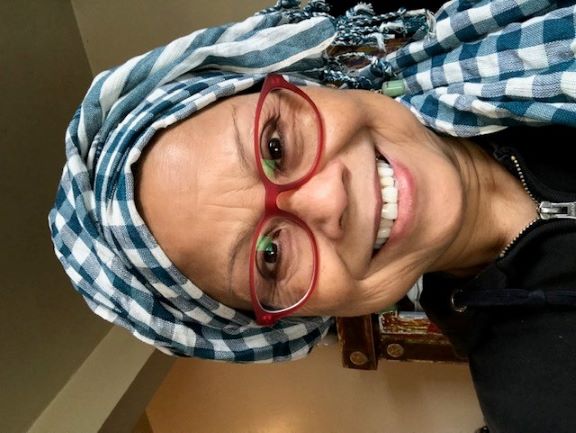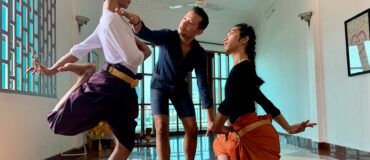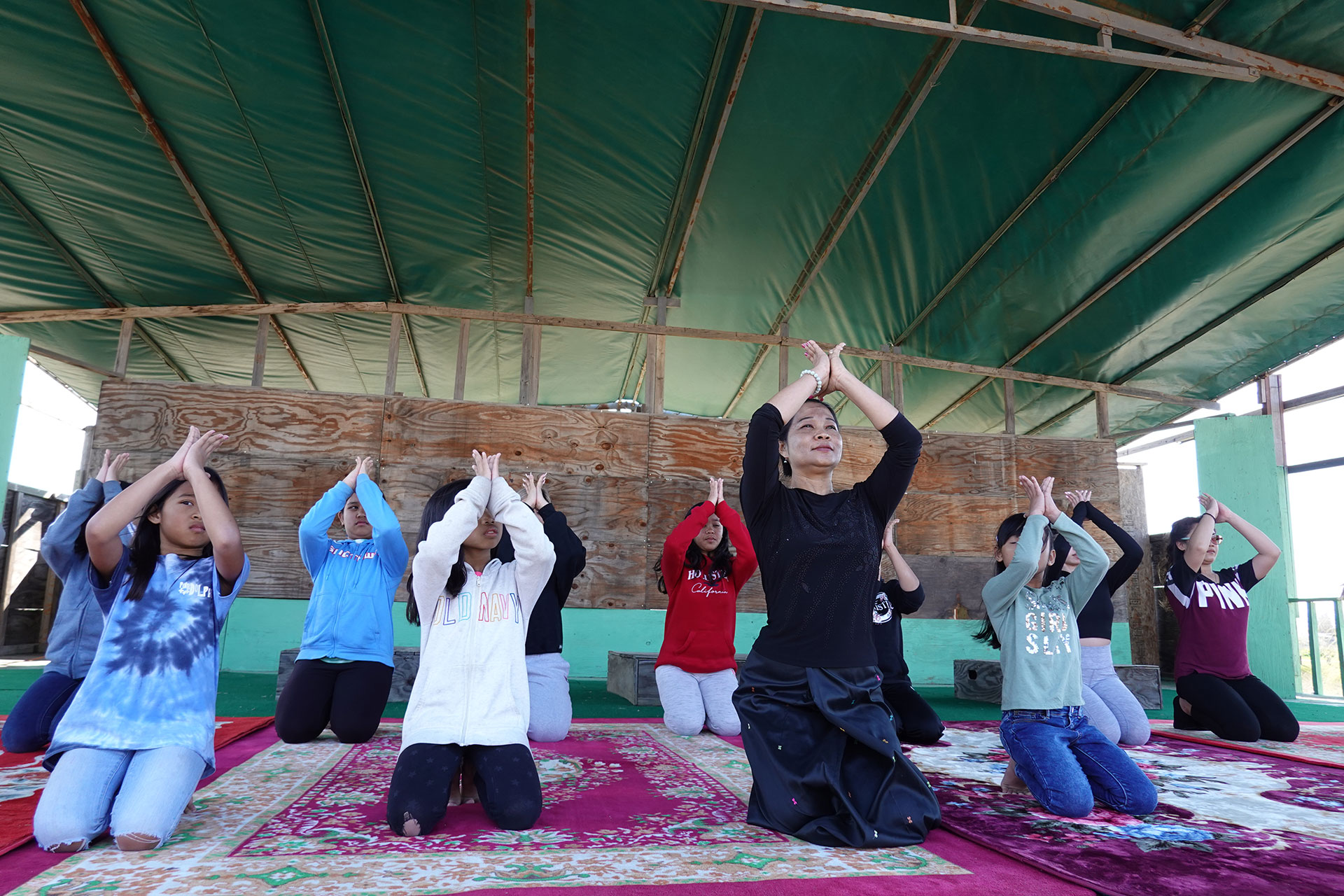‘What Are You?’ Dancemaking and the Hyphenated Other:
Christopher K. Morgan, Ananya Chatterjea, and Alleluia Panis
Editor’s note: This article is one of 11 in a series examining the creative work of 31 dance artists funded by Dance/USA Fellowship to Artists, generously supported by the Doris Duke Charitable Foundation. These artists’ practices are embedded in social change as they work in multiple dance forms in communities across the country.
 - medium.jpg)
Christopher K. Morgan’s choreographic explorations delve into identity, social and cultural issues. His works draw from his background in modern dance, hula, and Hawaiian chant. Pictured are Ashley Rivette, Abby Farina and Tiffanie Carson. Photo: Jonathan Hsu
By Lily Kharrazi
Can we value artistic difference without othering the artists who explore it? Many foreign-born or hyphenated Americans are asked the same question: “Where are you from?” This familiar trope can offer a sincere inquiry. Or it can signal a proverbial dog whistle, as the asker attempts to position an accented voice, textured hair, or eye shape. Otherness is perniciously present in the dance world. Particularly if an artist’s lexicon employs non-western movement, otherness can confound or distinguish how an artist’s work is perceived by funders, curators, presenters, marketers, audiences or even other artists.
How do indigenous and immigrant perspectives lift up artistic practices? The bold and original work of Christopher K. Morgan of Christopher K. Morgan & Artists, Washington, D.C.; Ananya Chatterjea and her Ananya Dance Theatre, Minneapolis; and Alleluia Panis and Kularts, San Francisco, reflect three creatives who have embraced, pushed against, and integrated the complexities of their identities into their repertoires and processes. Their work springs from a social consciousness integral to their cultural communities.
HONING IN TO THE SOURCE
Christopher K. Morgan’s life’s work has a 360-degree presence in the arts ecosystem. Early in his career he performed with companies in the United States and abroad. Since 2011, he has been the artistic and executive director of his namesake company and, since 2017, he plays the same roles at Dance Place in Washington, D.C., presenting 40 weeks of performance annually by national and international artists. In addition to exercising his curatorial vision, he oversees youth and adult classes at the busy venue. In summers, since 2006, he has directed Art Omi: Dance, a collaborative residency in Ghent, N.Y., bringing together 10 international dancer/choreographers whose common language is creativity. These varied experiences lend him facility and sensitivity as a cultural translator. Do these sensitivities intersect with his cultural background? I would say, “yes.”

Morgan danced hula as a child in California, far from his family’s Native Hawai’i. Pōhaku, an evening-length solo, reconnects him to his ancestry and artistic roots through storytelling, hula, modern dance, classical and Hawaiian music. Pōhaku, Hawaiian for stone, delves into fractured identity. Photo: Brianne Bland
For Morgan, who is Native Hawaiian, identity has been a journey, fully inhabiting roots that were there all along. He relays a watershed moment when he and several collaborators reviewed 14 years of his contemporary choreography while on a residency at the National Center for Choreography Akron. He recalls it as a “hiding in plain sight” moment. “I saw that a basic hula step, ka’o — an alternating rising and falling undulation of the pelvis present in nearly all hula movements — was ever present in my modern dance movement vocabulary!” The group observed this essential building block of hula repeatedly in Morgan’s movement. Ka’o was incorporated into warm-up exercises that also used balletic tendus and modern dance foot articulations, extended and elevated leg gestures, and release-technique-influenced floor work. This movement signature was solidly based in his formative experience dancing hula as a Hawaiian child born and raised in Orange County, Calif., home to one of the largest diasporic populations of Pacific Islanders in the U.S.

Morgan’s choreographic practice ventures from contemporary modern dance to his roots in traditional hula. His company, CKM&A, seeks to demystify contemporary dance through community dialogue and online video content. Photo: Brianne Bland
Hula as a system of cultural transmission lives not only in a series of movements, but in dialogue with chant, storytelling, implements of percussion, regalia, and community. As the youngest of eight children, Morgan performed in his family’s Polynesian revue. This group effort included “my mother constructing all of our costumes, representing not just Hawai’i, but also the cultures of Tahiti, Aotearoa, Samoa.” This story conveys a tenderness and layered poignancy of “performing culture.” From an early age he learned the building blocks of theater craft, as his sensitivities to the idea of otherness in performance grew. Morgan’s repertoire focuses on salient social and cultural concerns. Among his strongest and most recognized work to date is Pōhaku (2016), an exploration of his Native identity, personal in nature and layered with allusion to the effects of colonization. The piece, rich with traditional chant and movement, is contemporized by his extensive western modern dance training, creating a new aesthetic for both western and traditional Hawaiian viewers.
It may be that an artist never veers far from the source, as Morgan’s example might suggest.
NEW FRUITS FROM A GRAFTED TREE BRANCH
Ananya Chatterjea laughs when I ask her if she is exhausted yet, referring to the quandary of having to justify or explain herself as both a contemporary dance maker and a Bengali woman from South Asia (India). She is deliberate in explaining that her work is contemporary as opposed to “fusion,” in reference to her foundational training in Odissi, one of India’s eight classical dance forms. Situating her practice further, she continues, “I work within a network of transnational feminists …. My company is a collective dedicated to the stories and issues of women of color.”

On the beach at the Bay of Bengal, Ananya Chatterjea and collaborating photographer Ridwan encountered a fisherman and requested that he throw his fishing net over her. She reflects, “Fish have deep cultural relevance for Bengali peoples, in India, in Bangladesh, and the Bengali diaspora.” This photo symbolizes that shared heritage. Photo: Ridwan Adid Rupon
Journeying to New York City from Kolkata in the 1990s to study modern dance, Chatterjea arrived when multiculturalism was in full bloom. The appetite for non-western dance representation on stage or in studios amplified narrow notions of identity politics. The appeal to many American artists performing culturally specific dance was its sheer political statement: Who had access to a stage and who could challenge the valorization of western forms. For Chatterjea, already rooted in cultural identity, this construct was claustrophobic; as she explains, “I had to move away from the traditional stories of gods and goddesses.”
This anecdote reflects a posture that is remarkable: While questioning authority, she was also unpacking divinity and looking critically at the patriarchy suggested in the guru-shishya (preceptor-disciple) system. This deconstruction and fearlessness are characteristic of the choreography and themes performed by Ananya Dance Theatre, now 15 years old. With an unflinching feminist, womanist, and justice-centered approach to her social practice, Chatterjea interrogates dominant systems, whether her own Bengali roots or her American context. I wanted to know where this began.

Chatterjea’s company brings together cultural activists, BIPOC women and femme artists who believe in the transformative power of dance. In her works, they shift the landscape of mainstream culture to build understanding and empower artistic voices. Photo: Paul Virtucio
Growing up in Kolkata, she witnessed the rich traditions of Bengali women’s street theater, both as a platform for information and entertainment. She was encouraged to pursue dance, which is valued as a core art form in Indian society. She speaks about a neighborhood shrine that is holy to both Hindus and Muslims and that paid homage to a folk goddess, providing her an example of how two belief systems can co-exist, syncretically.
These experiences, which were so specific to a place, live among the bedrock that nurtures her artistic spirit and critical mind. Since 1999, Dr. Chatterjea has been dance professor at University of Minnesota, where she continues to expand upon her pedagogy. Her trajectory suggests that the tree can yield new fruits from a grafted branch. Among this new growth is the training methodology known as YorchhāTM. The trademarked system evolved from the intersection of Odissi, known for its strength while maintaining full and soft curves in space; the flow of yoga; and the precision of Chhau, a martial art from Odisha, eastern India. This careful melding of influences is the vehicle that upends both western and eastern dance practices. The result is entirely contemporary.
NEW WORLD VIEWS FROM INDIGENOUS CULTURE
Street banners over the Filipino Cultural Heritage District in downtown San Francisco are imprinted with faces representing the leaders in health care, business and labor, and their civic contributions as one of the largest migrations to California. Among the banners is the smiling face of Alleluia Panis, artist and cultural leader. She, too, at age 11, immigrated with her family adding to this rich and ongoing story.

Alleluia Panis’s In the Belly of the Eagle: Man@ng Is Deity immortalizes the 8,000-mile immigration journey her ancestors took to America. Inspired by Pilipinx Americans from the 1920s-60s, it reveals triumphs and hardships in a new land that only wanted cheap labor. Photo: Wilfred Galila
The Bay Area is an epicenter for the Pilipinx creative renaissance. Presently, more than seven active folkloric companies perform in the showcase format popularized by the renowned Bayanihan National Philippines Dance Company. Experimental artists explore questions of indigeneity and of intergenerational effects of colonization on their collective identities. The spoken word, hip hop, theater, and media works display a distinctly Pinoy brand. Traditional and folk arts have found new interest among second- and third-generation Pilipinx. This percolating scene circles back to Panis, whose organization, Kularts, prides itself on being “the nation’s premier presenter of contemporary and tribal Pilipinx art” and produces or fiscally sponsors many artist projects.
Panis’s artistic practice, based in modern and folkloric dance, is rooted in her immigrant experience. When pushed to define her hybrid movement approach, she answers thoughtfully, “I’ve always been challenged as to how to call my movement style. Diasporic Pilipinx is a mouthful but describes it best. The stories I’m telling with this movement language invention are specifically from [that] perspective.” She traces her work to its foundation: “The tribal repertoire of the national folkloric dance company was a major influence in my pursuit to travel to the Philippines and learn from the source.” In 1975, she was the first of her family to return to the Philippines. “I wanted to experience firsthand the physical environment of the place and the dances these people created. I wanted to learn the culture, indigenous practices, myths and beliefs.”
A life-changing experience happened in 1983, when Panis met and worked with the late National Endowment for the Arts Heritage Fellow and culture bearer Danongan Kalanduyan. The study of the brass gong music ensemble and dance-ritual traditions of the Muslim tribes of Mindanao would greatly alter her artistic viewpoint. Kalanduyan became the artist in residence between 1985 and 1988 at Kulintang Arts (now Kularts) impacting a generation of artists with his knowledge. “I travelled to Mindanao with Kulintang Arts Ensemble to visit indigenous communities and we toured Singapore and the Philippines,” Panis said. She refuses to call herself a traditional artist, however, reserving the term for those with deep roots in a traditional practice. Her work, she explains, is contemporary.

Director and choreographer Panis works in both Pilipino tribal and traditional arts and in American contemporary forms. As director of KulArts in San Francisco, she explores untapped narratives of Asian Americans through live and multimedia film works. Courtesy: A. Panis
Through Panis’s practice she challenges the colonial idea of what it means to be Pilipinx. With her deep dive into indigenous life, she uncovers world views that resonate with a new generation of artists, and with the blessings of the people “who I consider and consider me family.” Alleluia began to offer trips to Mindanao in 2002 to “replicate this immersive experience for other Pilipinx artists and cultural workers and fill this deep hunger to learn.”
For these three creatives, a question lingers: What would they do without having to explain themselves and their heritage so often?
“There is fatigue in explaining ethnicity and the labor that comes with the education of teaching past the tourist sheen and gloss of Hawai’i,” Morgan said. “The vulnerability ebbs and flows.” Chatterjea offers that even the current efforts toward diversity and inclusion can “feel like a pressure cooker, because artists essentially operate under an ‘exceptionalism’ model that provides little room for anyone perceived as the other.” As civic leader and artist, Panis acknowledges this tension and also offers a succinct statement that could speak for all three formidable artists: “What makes me special is my culture; it is a certain fire in the gut.”

Lily Kharrazi is an independent arts and culture consultant and a dance ethnologist by training. She serves as director of special initiatives with the Alliance for California Traditional Arts where for the past 15 years she has been a grant maker and program manager. She is a consultant to Dance/USA Fellowships to Artists.
Readers may read and print a PDF version of this article here. Readers may visit and share this article on Medium here. Please visit the artists’ websites: Ananya Chatterjea, Christopher K. Morgan, and Alleluia Panis. Find more information on the DFA Article Series here and more information on Dance/USA Fellowships to artists here.
____
We accept submissions on topics relevant to the field: advocacy, artistic issues, arts policy, community building, development, employment, engagement, touring, and other topics that deal with the business of dance. We cannot publish criticism, single-company season announcements, and single-company or single artist profiles. Additionally, we welcome feedback on articles. If you have a topic that you would like to see addressed or feedback, please contact communications@danceusa.org.
Disclaimer: Opinions expressed in guest posts do not necessarily represent the viewpoints of Dance/USA.





